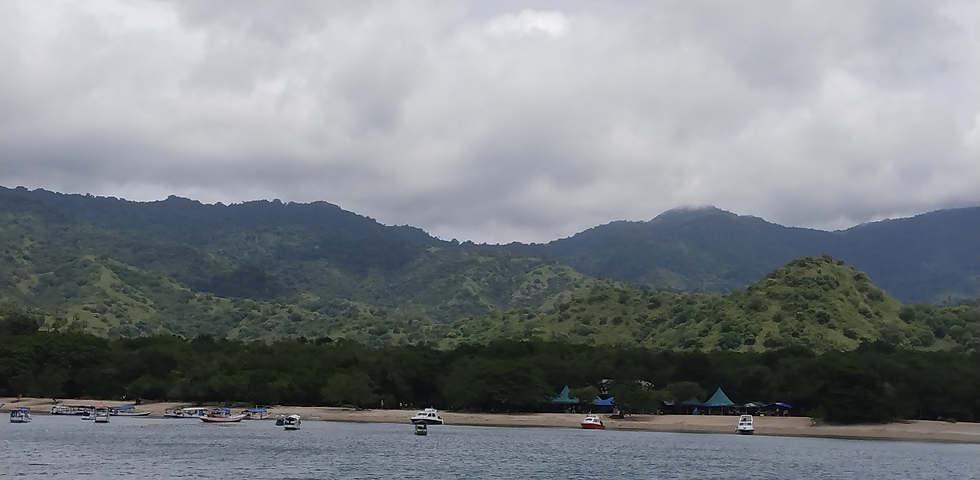Komodo Island, Indonesia
- acessig
- Mar 2, 2023
- 4 min read
Thursday, March 2, 2023

Visiting Komodo Island is definitely an adventure, with a tinge of danger in the mix. We boarded the ship’s lifeboat for tendering to shore, and faced something more frightening than any dragons we were to encounter — the crumbling brick steps with no handrail that we were required to step out onto from the tender up to the long concrete pier.

We saw a lovely beach with deep turquoise water, and lying on the shore were a couple of smaller Komodo dragons, seemingly oblivious to the children playing in the water on the opposite side of the pier. The verdant mountains all around the harbor were as prehistoric looking as the Komodo dragons themselves.

Three guides met each group onshore, each carrying a long wooden forked stick. As we walked through Komodo Island National Park, the guide led the group and provided information, another walked in the middle, and the other in the back. Each group had about 20 people. We were instructed to remain silent and stay together during the tour. A large sign stated “Complete Silence.”
I can understand why the government has been considering shutting down Komodo Island to tourism. The number of dragons has been declining as tourism has increased. As you read further, you might agree with me that, while it might have a negative impact on the economy, ending tourism to the island could help preserve the creatures and their habitat.
There were several groups walking the paths at the same time, often passing each other as one group would pause to take photos. It wasn’t far into the 4 kilometer walk that we came upon a watering hole that had been dug by the park rangers for the dragons. Three very large dragons were lounging at the spot, flickering their tongues, their heads tilted. One of them seemed interested in us visitors, so the guide moved us around to the other side of the circular opening.
For this particular day, 100 percent rain had been predicted, but we were very fortunate that the rain had cleared out before our 9:30 tour. The paths were muddy, with rocks and roots providing a bit of an obstacle course, and sometimes the grasses had grown over the path so much, that it was barely a foot wide.
After we saw the dragons, we headed up the hill. Because the hot, humid weather in the tropics can be brutal for those who are not accustomed to it, some of the tourists were starting to succumb to it. We were warned before embarking up the hill that it would be difficult, and it was strongly suggested that those who might not want to chance the trek should return back to shore with another group.
Yet everyone in our group decided to go forward, including elderly people who had difficulty walking as it is, much less on rugged uphill terrain. Regardless, they chose to take this trek which was clearly labeled “strenuous,” and suffered as a result of it. A wheelchair was brought for one woman, and we later found out that someone was carried out of the park on a stretcher.
Once downhill, we crossed over a bridge and then found ourselves back at the beach. We then crossed another bridge, and there was only one way we could go — through a gauntlet of a market with exceptionally aggressive hawkers, including little children. Each booth seemed to have pretty much the same things — wooden carvings of Komodo dragons, refrigerator magnets, fake pearl necklaces, shells, t-shirts, and scarves.
As we left the market in a quickstep, I saw a darling group of toddlers running around playing, and turned to take a photo. Suddenly, a barefoot mother streaked by, grabbing up a toddler and clutching him to her breast. Other parents started running toward the children as well. We turned around, and coming right at us, in his slow pace, head swinging side to side, was the largest Komodo dragon we had seen yet. He was just making his way through the crowds like it was no big deal, but I suspect he might have had his eye on the smallest of the toddlers. Three men with wooden forks quietly herded the beast to the shore by beating the ground with the forked stick, keeping their distance, calmly allowing the dragon its space.

As the dragon rested on the sand, the men stepped back and away. Then out of nowhere, a tourist walked down the beach and stood right beside the dragon, gawking at it. Astounded, the local guides shouted at him to get away. Not only is it exceptionally dangerous to approach the dragons, but it is very stressful for them as well. Just the sheer numbers of tourists brought on to the island at one time is reason enough for giving Komodo Island a break from tourism for a while.

It makes no sense that someone might visit this island without researching Komodo dragons and having the sense not to approach one. If you are bitten by a Komodo dragon’s shark-like teeth, the venom will very rapidly enter your bloodstream. Your blood pressure will drop, which causes blood loss to increase rapidly, and you will go into shock. A victim could die within a few hours. They can spring up to 15 miles per hour, can swim and dive 15 feet deep, and climb trees.
Seeing the largest lizard in the world in its natural habitat was truly a privilege. However, by controlling the numbers of people allowed to visit the island at once, perhaps Indonesia can preserve this national treasure for many generations.
Komodo Island felt like a No Man’s Land — rugged, primitive, and mysterious. It was like traveling back in time into an ancient wilderness, and feeling like something there in that thick brush is watching us.



Comments